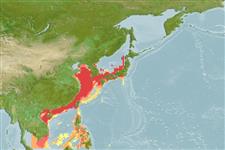分類 / Names
共通名の | 類義語 | Catalog of Fishes(部類, 種) | ITIS | CoL | WoRMS | Cloffa
板鰓亜鋼(サメとエイ類) (sharks and rays) >
Orectolobiformes (Carpet sharks) >
Orectolobidae (Carpet or nurse sharks)
Etymology: Orectolobus: orektos (Gr.), stretched out; lobus (L.), from lobos (Gr.), rounded projection or protuberance, referring to long nasal barbels of Squalus barbatus (=O. maculatus). (See ETYFish); japonicus: -icus (L.), belonging to: Japan, described from two specimens, both from Japan. (See ETYFish).
More on author: Regan.
Environment: milieu / climate zone / depth range / distribution range
生態学
海 底生の; 深さの範囲 0 - 200 m (Ref. 106604). Tropical; 43°N - 6°N, 103°E - 140°E
Western Pacific: Japan and Korea to Viet Nam.
Length at first maturity / サイズ / 重さ / 年齢
Maturity: Lm ?, range 103 - ? cm
Max length : 118 cm TL オス/雌雄の選別がない; (Ref. 106604)
簡単な記述
検索表 | 形態学 | 形態計測学
背面の脊椎 (合計) : 0; 肛門の骨: 0. Five to six dermal flaps below and in front of eyes; back with light areas between dark saddles marked with broad reticulated dark lines (Ref. 13577). Caudal fin with its upper lobe hardly elevated above the body axis, with a strong terminal lobe and subterminal notch but no ventral lobe (Ref. 13577).
A little-known bottom shark found inshore (Ref. 247); usually in sand or sandy mud bottoms (Ref. 11230); also on rocky and coral reefs (Ref. 43278). Nocturnal in habits (Ref. 247). Feeds on fish and presumably bottom invertebrates (Ref. 247), including lizardfishes, cutlassfish, horse mackerel and other jacks, goatfishes, groupers, tilefishes, sea robins, whiting, parrotfishes, sea bream, croakers, also skates, shark egg cases, cephalopods, and shrimp (Ref. 43278). Ovoviviparous (Ref. 43278, 50449), with up to 20 young in a litter (Ref. 247). Wobbegongs should be regarded as potentially dangerous because of its formidable dentition (Ref. 247, 13577). Used for human consumption (Ref. 247). Kept in aquaria in Japan and the United States (Ref. 43278).
Life cycle and mating behavior
Maturities | 繁殖 | Spawnings | Egg(s) | Fecundities | 幼生
Ovoviviparous, embryos feed solely on yolk (Ref. 50449). With up to 20 young in a litter (Ref. 247).
Compagno, L.J.V., 1984. FAO Species Catalogue. Vol. 4. Sharks of the world. An annotated and illustrated catalogue of shark species known to date. Part 1 - Hexanchiformes to Lamniformes. FAO Fish. Synop. 125(4/1):1-249. Rome, FAO. (Ref. 247)
Human uses
水産業: 少数商業の
用具
特記事項
XMLをダウンロードして下さい
インターネットの情報源
Estimates based on models
Preferred temperature (Ref.
123201): 14.5 - 27.7, mean 24 °C (based on 222 cells).
Phylogenetic diversity index (Ref.
82804): PD
50 = 0.5012 [Uniqueness, from 0.5 = low to 2.0 = high].
Bayesian length-weight: a=0.00389 (0.00180 - 0.00842), b=3.12 (2.94 - 3.30), in cm total length, based on all LWR estimates for this body shape (Ref.
93245).
栄養段階 (Ref.
69278): 3.8 ±0.57 se; based on food items.
回復力 (Ref.
120179): 低い, 4.5年~14年の倍増期間の最小個体群 (Fec=20).
Fishing Vulnerability (Ref.
59153): High to very high vulnerability (71 of 100).
